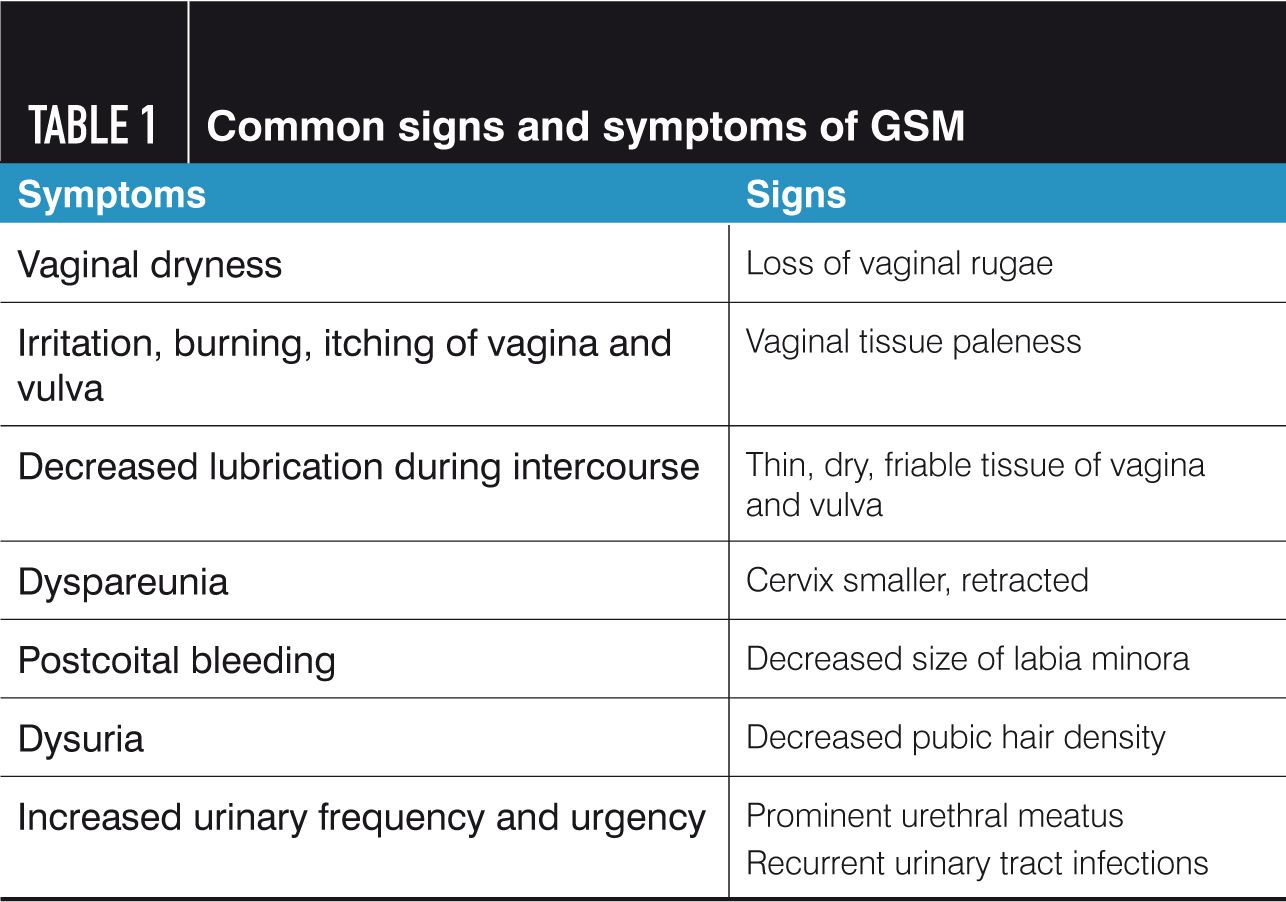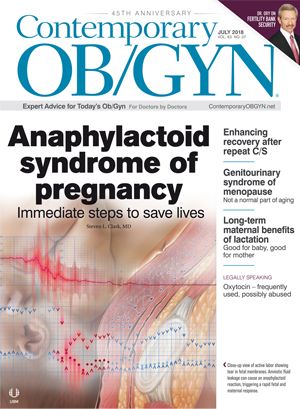Genitourinary syndrome of menopause: Underdiagnosed and undertreated
Despite the prevalence of GSM, the condition continues to be under-recognized and undertreated due to a combination of patient and provider factors. Providers need to take the initiative in screening and patient education.
Introduction
Genitourinary syndrome of menopause (GSM) is a relatively new term that describes the constellation of lower urogenital tract signs and symptoms associated with a low-estrogen state.1 Prior nomenclature such as vulvovaginal atrophy and atrophic vaginitis failed to encompass the frequent urinary symptoms associated with menopause. GSM, which arose from a 2013 terminology consensus conference by the International Society for the Study of Women’s Sexual Health (ISSWSH) and North American Menopause Society (NAMS), is seen as a more generalizable and inclusive term with fewer negative connotations that should replace older jargon.
GSM describes the genital, sexual and urinary changes in the lower genital tract associated with menopause. It is a chronic disorder that is unlikely to improve over time without treatment. The estrogen receptors present throughout the lower genitourinary tract respond to the decrease in circulatory estrogen after menopause with thinning of the vaginal and uro-epithelium, an increase in vaginal pH, decreases in collagen and tissue elasticity and fewer blood vessels. Physiologically, this manifests with symptoms of vaginal dryness, vaginal irritation, vaginal itching and may affect sexual function due to dyspareunia and diminished lubrication (Table 1). It is important to note that GSM also includes urologic signs and symptoms. Postmenopausal patients are more prone to recurrent urinary tract infections (UTIs), dysuria, urinary frequency and urgency.2

Prevalence
GSM can be clinically detected in up to 90% of postmenopausal women undergoing evaluation. However, only about one-third of menopausal women report vulvovaginal symptoms when surveyed.3 According to the 2010 United States census, there are approximately 50 million women over age 51, the average age of menopause.4,5 That means approximately 17 million women experience GSM symptoms, a number that is likely increasing due to population demographics. Studies have shown that many of these women rate their symptoms as either moderate or severe. Affected women perceive declines in quality of life similar to those of patients with chronic conditions such as arthritis, chronic obstructive pulmonary disease (COPD) and irritable bowel syndrome.6 GMS symptoms also negatively impact sexual satisfaction in over half of patients and strain personal relationships.7
Despite the prevalence of GSM, the condition continues to be under-recognized and undertreated due to a combination of patient and provider factors. Only about one-quarter of women ever discuss their symptoms with a provider. Frequently, the burden falls on the patient to initiate the conversation.8 The most common barrier to patients discussing GSM is a belief that their symptoms should just be accepted as a natural part of aging and menopause.8 Other women fail to even link their symptoms with menopause.7 This demonstrates a large gap in patient knowledge and an opportunity to educate patients on GSM as a medical condition. Providers need to take the initiative in screening and patient education. However, studies have shown that providers are doing a poor job at this. One study found that only 13% of providers queried their patients for GSM symptoms.1 Even after diagnosis, the majority of women with GSM go untreated despite studies demonstrating a negative impact on quality of life. Hesitation to prescribe treatment by providers as well as patient-perceived concerns over safety profiles limit use of topical vaginal therapies.7,8
Treatment
The primary goal of GSM treatment is symptom relief. Options include lifestyle changes and non-hormonal and hormonal treatments. Hormonal therapies include both topical and systemic approaches. Vaginal lasers marketed for GSM have also recently arrived on the market. The theory behind laser therapy is that collagen growth is stimulated, thereby strengthening the vagina. However, medical evidence from controlled, randomized clinical trials (RCTs) on which to base a recommendation is lacking at this time.
Lifestyle modifications
Tobacco abuse has been associated with increased atrophic vaginal changes as well as menopause at a younger age.9 Tobacco cessation should be encouraged. Some providers recommend regular sexual intercourse, including the Society of Obstetricians and Gynaecologists of Canada.10 While more sexual activity is associated with fewer atrophic changes and GSM,11 it is unclear whether this finding reflects the fact that intercourse improves symptoms, or rather, that patients with fewer symptoms and less dyspareunia are more likely to engage in intercourse. The latter may well be the more likely explanation. General vulvar hygiene should be maintained with the goal of keeping the area dry and free of irritants. Cotton underwear is preferable, as well as avoidance of fragrance-containing products.
Non-hormonal therapy
Non-hormonal therapies for GSM include vaginal moisturizers and lubricants. Vaginal moisturizers function to replace natural vaginal secretions while vaginal lubricants reduce friction during intercourse. Moisturizers commonly contain molecules that are capable of retaining large amounts of water and releasing them slowly. Examples include hyaluronic acid and polycarbophil gel. Some moisturizers have a low pH to help acidify the vaginal environment back to premenopausal physiologic levels; however, products with a pH of less than three should be avoided. Lubricants are also typically water-based but contain additional oil, glycerin, or silicone. The osmolality of the lubricant should also be taken into account. Certain brands are markedly hyperosmolar, such as Astroglide, KY Jelly, and Replens. Although these agents are often effective, their high osmolality can theoretically dehydrate the adjacent vaginal epithelium and cause irritation.12 Vaginal moisturizers and lubricants provide temporary relief and may be sufficient for patients with only mild symptoms. Other non-hormonal options such as black cohosh or soy have not been shown to improve GSM.13 These are not recommended for treatment.

Vaginal estrogen and alternatives
The gold standard pharmacologic treatment for GSM is still vaginal estrogen, especially for patients who are not suffering from systemic symptoms of menopause. Low-dose vaginal estrogen is effective and safe (Table 2).14-17 Vaginal formulations act locally to target GSM symptoms, and result in minimal, transient elevations of circulating estradiol. Oral estrogen preparations should be reserved for primary treatment of vasomotor and other systemic menopausal symptoms. Patients who are on systemic hormonal therapy (HT) may still have GSM symptoms and therefore may get additional benefit from topical estrogen if they do not note sufficient improvement after a few months of systemic dosing. Vaginal estrogen, supplied as either estradiol or conjugated equine estrogen, comes in a variety of low-dose formulations including creams, rings and tablets. The different formulations are all considered equally effective. A new vaginal estrogen in the form of an estradiol soft gel is currently in phase III trials, formulated to not require an applicator for insertion and to dissolve faster, with less vaginal discharge than other preparations.18
Ultimately, the specific vaginal estrogen formulation should be personalized for individual patients according to cost, convenience and preference. Patients are typically instructed on daily use during initiation, then to decrease frequency to twice weekly. Cessation of treatment is expected to lead to a return of symptoms. Compounded estrogen products are not recommended for use due to variability in production with inconsistent strengths, no data on individual pharmacokinetics of a vaginally administered dose, and lack of safety data.
Various studies have demonstrated the safety of vaginal estrogen. Women using low-dose vaginal estrogen tablets and rings have a very small increase in serum estradiol levels that remains well within the normal postmenopausal range.19 Data from the Women’s Health Initiative have also demonstrated the relative safety of vaginal estrogen preparations. Over 45,000 women using either vaginal estrogen cream or tablet were followed. On average, women used vaginal estrogen for a median duration of two years for a median follow-up of seven years.20 Vaginal estrogen users had similar rates of endometrial cancer, invasive breast cancer and pulmonary embolism/deep vein thrombosis as non-users. In fact, risks of coronary heart disease, fracture and all-cause mortality were lower in vaginal estrogen users.20
Multiple studies have investigated the endometrial safety of vaginal estrogen, including two randomized controlled trials (RCTs) that documented no difference in endometrial hyperplasia or cancer with endometrial biopsy samples after 12 months of vaginal estrogen exposure.21,22 Additional progestin for endometrial protection, therefore, is not thought to be needed during low-dose vaginal estrogen use. Contraindications to vaginal estrogen use include unexplained uterine bleeding, endometrial hyperplasia or cancer and use of aromatase inhibitors (AIs).
The packaging for vaginal estrogen includes the same information as for systemic estrogen. The package insert includes a “black box” warning, which states an increased risk of: “endometrial cancer, cardiovascular disorders, breast cancer and probable dementia.” This warning, which understandably frightens patients, is applied by the US Food and Drug Administration (FDA) to any estrogen-containing pharmaceutical. Yet all of the data supporting this warning derives from clinical trials involving systemic hormone exposure at much higher doses. With the current abundant data that exist demonstrating the differences in safety profiles and serum estrogen levels between vaginal estrogen and oral estrogen, NAMS and other organizations have teamed up to recommend to the FDA that the boxed warning be removed from topical estrogen preparations.23
Alternatives to estrogen for treatment of GSM include selective estrogen receptor modulators (SERM). SERMs act to stimulate estrogen receptors in certain tissues while blocking them in others. The most well-known SERMs were designed to treat breast cancer. Specific SERMs are now on the market to treat GSM and serve as pharmacologic alternatives for women who are not candidates for estrogen use. Ospemifene has been available since 2013 and is approved for treatment of dyspareunia due to GSM as a daily oral tablet. Studies have demonstrated improvement in GSM symptoms compared to placebo.24 Ospemifene acts as an agonist on vaginal epithelium while avoiding a stimulatory effect on endometrial and breast tissue. Endometrial safety, based on endometrial thickness, has been demonstrated out to one year of use.25 Ospemifene has an antagonistic effect on breast tissue in ex vivo studies, however, its use and safety in patients with a history of breast cancer has yet to be studied.26Side effects of ospemifene that may limit its use include an increase in hot flashes, need for daily, systemic administration, and delayed therapeutic effect.24Many women do not see benefits until about six months after initiation. Venous thromboembolism (VTE) risk is also a concern for any SERM and the safety of ospemifene appears similar to other SERMs, with a small increase in risk that is not as much as the risk seen with estrogen. Lasofoxifene is another SERM not yet approved for use in the United States. It has been shown to help GSM symptoms while also improving bone density and decreasing breast cancer risk in a postmenopausal population.27,28 However, lasofoxifene has also been associated with an increase in endometrial polyps, though not necessarily hyperplasia or cancer.29 Lasofoxifene seems promising as a possible treatment option in patients with a history of breast cancer but as of now, it remains in phase III development. We suggest use of ospemifene for patients who fail over-the-counter treatments and who have contraindications to vaginal estrogen treatment or who strongly want to avoid estrogen therapy. Providers should be aware that ospemifene packaging contains a black box warning regarding VTE risk.
The newest alternative to vaginal estrogen treatment is vaginal dehydroepiandrosterone (DHEA), also known as prasterone, which was approved in 2016 for dyspareunia related to GSM. Prasterone likely works by local conversion of androstenedione and testosterone into estrone and estradiol. In RCTs, prasterone has been shown to decrease dyspareunia compared to placebo in postmenopausal women.30 Prasterone increases circulating DHEA, testosterone, and estrone, however, hormone levels are maintained within normal postmenopausal ranges after 12 weeks.31 Studies regarding prasterone safety in patients with a history of cancer, specifically, breast cancer, have not been conducted yet. Prasterone is a vaginal insert that, unlike vaginal estrogen, requires daily administration.
Though there have not been head-to-head trials comparing ospemifene or prasterone against vaginal estrogen, the efficacy of vaginal estrogen has been well demonstrated and its safety profile is far lengthier than that of the current alternatives. In addition, vaginal estrogen does not require daily administration unlike ospemifene or prasterone. We still recommend vaginal estrogen as a first-line option for patients who seek pharmaceutical treatment for GSM.
Fractional carbon dioxide (CO2) laser therapy, popularly called “vaginal rejuvenation,” has been proffered as an attractive alternative to hormonal therapy. Laser treatments use CO2 wavelengths to ablate and coagulate mucosal tissue, thereby stimulating wound healing and tissue remodeling with increased collagen formation. Treatment usually consists of a series of short in-office procedures six weeks apart that can cost thousands of dollars. Early case series and other clinical studies have demonstrated improvement in GSM symptoms, however, these studies suffer from small sample sizes (few with more than 20 women), a lack of randomization, no placebo-treated control group, and short follow-up (20 weeks). One small (sample size 45) RCT comparing CO2laser with vaginal estrogen, each agent alone, both combined, with a no-treatment control group, demonstrated that in the combined treatment group, symptom improvement was greater than treatment with vaginal estrogen alone. However, laser therapy alone was associated with worse dyspareunia.32,33
Larger studies demonstrating long-term safety and efficacy, as well as an analysis of cost-effectiveness, are needed before this modality can be recommended. Moreover, laser therapy for GSM is not FDA-approved at this time. The American College of Obstetricians and Gynecologists’ most recent position statement on laser therapy from May 2016 emphasizes the importance of accurately informing patients of a treatment’s FDA status. It advises providers to be wary regarding new trends based on “promotions or marketing.” 34
Breast cancer and GSM
A history of breast cancer complicates treatment of GSM, especially for women with hormone receptor-positive histology. GSM complaints are common in this patient population, especially among patients treated with AIs. First-line therapy should always include non-hormonal vaginal moisturizers and lubricants. If those fail, low-dose vaginal estrogen can be considered. An individualized decision should be made in conjunction with the patient’s oncologist. Few studies have demonstrated vaginal estrogen safety in breast cancer patients. One prospective cohort study followed 69 women with a history of breast cancer who used vaginal estrogen for an average of one year. The study found no increased risk of breast cancer recurrence.35 However, this study was limited by its small sample size and relatively brief follow-up. Larger and longer-term studies are needed to provide more confidence that low-dose vaginal estrogen will not affect breast cancer recurrence rates. If vaginal estrogen is to be used for compassionate reasons, preparations that result in the lowest systemic estradiol concentrations are recommended and treatment should be for the shortest duration possible. Patients using AIs may be at risk if they use vaginal estrogen. A small study demonstrated a rise in serum estradiol levels in six women using Vagifem while taking AIs, thereby eliminating the goal of maximally suppressing estrogen levels.36 Clearly, this is a setting in which shared decision-making with an informed patient is of paramount importance.
Conclusion
GSM continues to be underreported and undertreated, despite the large number of postmenopausal women suffering from this chronic condition. Patients may suffer silently, perceiving their symptoms to be a natural aspect of aging, or may be hesitant to bring up this sensitive issue with their providers. Providers have much room to improve on screening patients for GSM.
Treatment should always start non-pharmacologically with topical moisturizers and lubricants. For those who require prescription therapy, we recommend vaginal estrogen in cream, ring or tablet form. Multiple formulations may need to be trialed before finding a price point acceptable to the patient as insurance coverage varies greatly. Systemic estrogen therapy should be reserved for primary treatment of other, body-wide menopausal symptoms. Patients taking systemic estrogen may still suffer from GSM and could benefit from additional vaginal estrogen therapy.
Ospemifene is an alternative prescription option for GSM that is approved by the FDA and may be a good option for patients with a history of breast cancer or who want to avoid estrogen, however, it may increase hot flashes and requires daily oral dosing. The need for more long-term data on prasterone prohibits us from recommending it as a treatment option at this time. Laser therapies also require larger studies on long-term efficacy, safety and cost-effectiveness.
NEXT: Download the patient education handout
A downloadable handout for your patient to help educate her about GSM.
Having trouble viewing?
Click to downloadTrouble viewing this PDF?

Once you access the file, position your mouse over the top middle for a toolbar:

Disclosures:
The authors report no potential conflicts of interest with regard to this article.
References:
- Portman DJ, Gass ML. Genitourinary syndrome of menopause: new terminology for vulvovaginal atrophy from the International Society for the Study of Women’s Sexual Health and the North American Menopause Society. Maturitas. 2014;79(3):349-354.
- Brown JS, Vittinghoff E, Kanaya AM, et al. Urinary tract infections in postmenopausal women: effect of hormone therapy and risk factors.Obstet Gynecol. 2001;98(6):1045-1052.
- Palacios S, Nappi RE, Bruyniks N, Particco M, Panay N, Investigators ES. The European Vulvovaginal Epidemiological Survey (EVES): prevalence, symptoms and impact of vulvovaginal atrophy of menopause. Climacteric. 2018;21(3):286-291.
- Howden LM, Julia. Age and Sex Composition: 2010. In. Commerce USDo, trans. United States Census Bureau: U.S. Census Bureau; 2010.
- Avis NE, McKinlay SM. The Massachusetts Women’s Health Study: an epidemiologic investigation of the menopause. J Am Med Womens Assoc (1972). 1995;50(2):45-49, 63.
- DiBonaventura M, Luo X, Moffatt M, Bushmakin AG, Kumar M, Bobula J. The Association Between Vulvovaginal Atrophy Symptoms and Quality of Life Among Postmenopausal Women in the United States and Western Europe. J Womens Health(Larchmt). 2015;24(9):713-722.
- Kingsberg SA, Wysocki S, Magnus L, Krychman ML. Vulvar and vaginal atrophy in postmenopausal women: findings from the REVIVE (REal Women’s VIews of Treatment Options for Menopausal Vaginal ChangEs) survey. J Sex Med. 2013;10(7):1790-1799.
- Kingsberg SA, Krychman M, Graham S, Bernick B, Mirkin S. The Women’s EMPOWER Survey: Identifying Women’s Perceptions on Vulvar and Vaginal Atrophy and Its Treatment. J Sex Med. 2017;14(3):413-424.
- Kalogeraki A, Tamiolakis D, Relakis K, et al. Cigarette smoking and vaginal atrophy in postmenopausal women. In Vivo. 1996;10(6):597-600.
- Society of O, Gynaecologists of C. SOGC clinical practice guidelines. The detection and management of vaginal atrophy. Number 145, May 2004. Int J Gynaecol Obstet. 2005;88(2):222-228.
- Leiblum S, Bachmann G, Kemmann E, Colburn D, Swartzman L. Vaginal atrophy in the postmenopausal woman. The importance of sexual activity and hormones. JAMA. 1983;249(16):2195-2198.
- Dezzutti CS, Brown ER, Moncla B, et al. Is wetter better? An evaluation of over-the-counter personal lubricants for safety and anti-HIV-1 activity. PLoS One. 2012;7(11):e48328.
- Reed SD, Newton KM, LaCroix AZ, Grothaus LC, Grieco VS, Ehrlich K. Vaginal, endometrial, and reproductive hormone findings: randomized, placebo-controlled trial of black cohosh, multibotanical herbs, and dietary soy for vasomotor symptoms: the Herbal Alternatives for Menopause (HALT) Study. Menopause. 2008;15(1):51-58.
- Simon JA, Reape KZ, Wininger S, Hait H. Randomized, multicenter, double-blind, placebo-controlled trial to evaluate the efficacy and safety of synthetic conjugated estrogens B for the treatment of vulvovaginal atrophy in healthy postmenopausal women. Fertil Steril. 2008;90(4):1132-1138.
- Freedman M, Kaunitz AM, Reape KZ, Hait H, Shu H. Twice-weekly synthetic conjugated estrogens vaginal cream for the treatment of vaginal atrophy. Menopause. 2009;16(4):735-741.
- Simon J, Nachtigall L, Gut R, Lang E, Archer DF, Utian W. Effective treatment of vaginal atrophy with an ultra-low-dose estradiol vaginal tablet. Obstet Gynecol. 2008;112(5):1053-1060.
- Bachmann G, Bouchard C, Hoppe D, et al. Efficacy and safety of low-dose regimens of conjugated estrogens cream administered vaginally. Menopause. 2009;16(4):719-727.
- Constantine GD, Simon JA, Pickar JH, et al. The REJOICE trial: a phase 3 randomized, controlled trial evaluating the safety and efficacy of a novel vaginal estradiol soft-gel capsule for symptomatic vulvar and vaginal atrophy. Menopause. 2017;24(4):409-416.
- Santen RJ. Vaginal administration of estradiol: effects of dose, preparation and timing on plasma estradiol levels. Climacteric : the journal of the InternationalMenopause Society. 2015;18(2):121-134.
- Crandall CJ, Hovey KM, Andrews CA, et al. Breast cancer, endometrial cancer, and cardiovascular events in participants who used vaginal estrogen in the Women’s Health Initiative Observational Study. Menopause. 2018;25(1):11-20.
- Ulrich LS, Naessen T, Elia D, Goldstein JA, Eugster-Hausmann M, investigators VAGt. Endometrial safety of ultra-low-dose Vagifem 10 microg in postmenopausal women with vaginal atrophy. Climacteric : the journal of the International Menopause Society. 2010;13(3):228-237.
- Simon J, Nachtigall L, Ulrich LG, Eugster-Hausmann M, Gut R. Endometrial safety of ultra-low-dose estradiol vaginal tablets. Obstet Gynecol. 2010;116(4):876-883.
- Manson JE, Goldstein SR, Kagan R, et al. Why the product labeling for low-dose vaginal estrogen should be changed. Menopause. 2014;21(9):911-916.
- Portman DJ, Bachmann GA, Simon JA, Ospemifene Study G. Ospemifene, a novel selective estrogen receptor modulator for treating dyspareunia associated with postmenopausal vulvar and vaginal atrophy. Menopause. 2013;20(6):623-630.
- Constantine GD, Goldstein SR, Archer DF. Endometrial safety of ospemifene: results of the phase 2/3 clinical development program. Menopause. 2015;22(1):36-43.
- Eigeliene N, Kangas L, Hellmer C, Kauko T, Erkkola R, Harkonen P. Effects of ospemifene, a novel selective estrogen-receptor modulator, on human breast tissue ex vivo. Menopause. 2016;23(7):719-730.
- Cummings SR, Ensrud K, Delmas PD, et al. Lasofoxifene in postmenopausal women with osteoporosis. N Engl J Med. 2010;362(8):686-696.
- LaCroix AZ, Powles T, Osborne CK, et al. Breast cancer incidence in the randomized PEARL trial of lasofoxifene in postmenopausal osteoporotic women. J Natl Cancer Inst. 2010;102(22):1706-1715.
- Goldstein SR, Neven P, Cummings S, et al. Postmenopausal Evaluation and Risk Reduction With Lasofoxifene (PEARL) trial: 5-year gynecological outcomes. Menopause. 2011;18(1):17-22.
- Labrie F, Archer DF, Koltun W, et al. Efficacy of intravaginal dehydroepiandrosterone (DHEA) on moderate to severe dyspareunia and vaginal dryness, symptoms of vulvovaginal atrophy, and of the genitourinary syndrome of menopause. Menopause. 2016;23(3):243-256.
- Ke Y, Labrie F, Gonthier R, et al. Serum levels of sex steroids and metabolites following 12 weeks of intravaginal 0.50% DHEA administration. J Steroid Biochem Mol Biol. 2015;154:186-196.
- Salvatore S, Nappi RE, Zerbinati N, et al. A 12-week treatment with fractional CO2 laser for vulvovaginal atrophy: a pilot study. Climacteric : the journal of the International Menopause Society. 2014;17(4):363-369.
- Cruz VL, Steiner ML, Pompei LM, et al. Randomized, double-blind, placebo-controlled clinical trial for evaluating the efficacy of fractional CO2 laser compared with topical estriol in the treatment of vaginal atrophy in postmenopausal women. Menopause. 2018;25(1):21-28.
- Fractional Laser Treatment of Vulvovaginal Atrophy and U.S. Food and Drug Administration Clearance [press release]. The American College of Obstetricians and Gynecologists, May 2016 2016.
- Dew JE, Wren BG, Eden JA. A cohort study of topical vaginal estrogen therapy in women previously treated for breast cancer. Climacteric : the journal of the International Menopause Society. 2003;6(1):45-52.
- Kendall A, Dowsett M, Folkerd E, Smith I. Caution: Vaginal estradiol appears to be contraindicated in postmenopausal women on adjuvant aromatase inhibitors. Ann Oncol. 2006;17(4):584-587.

